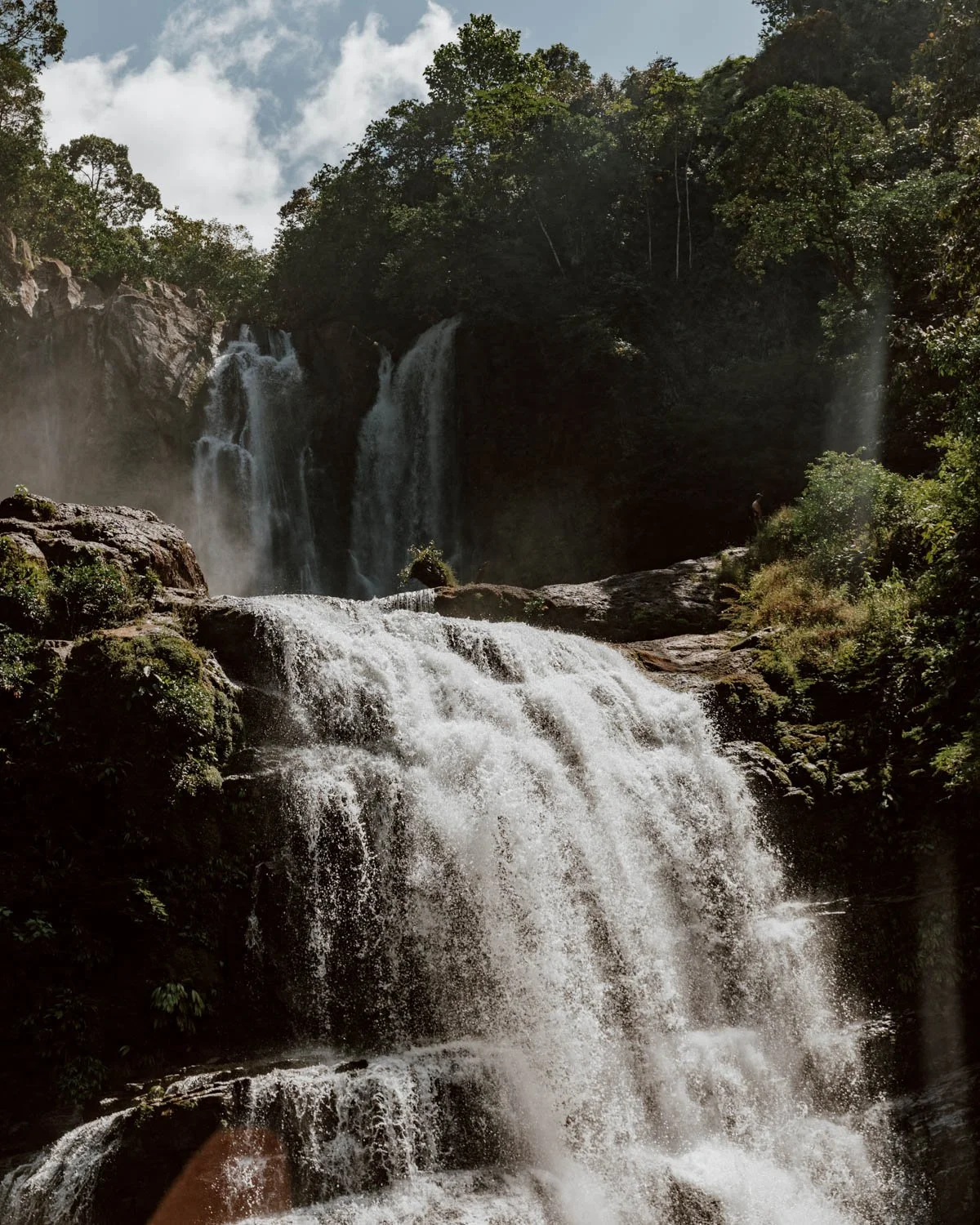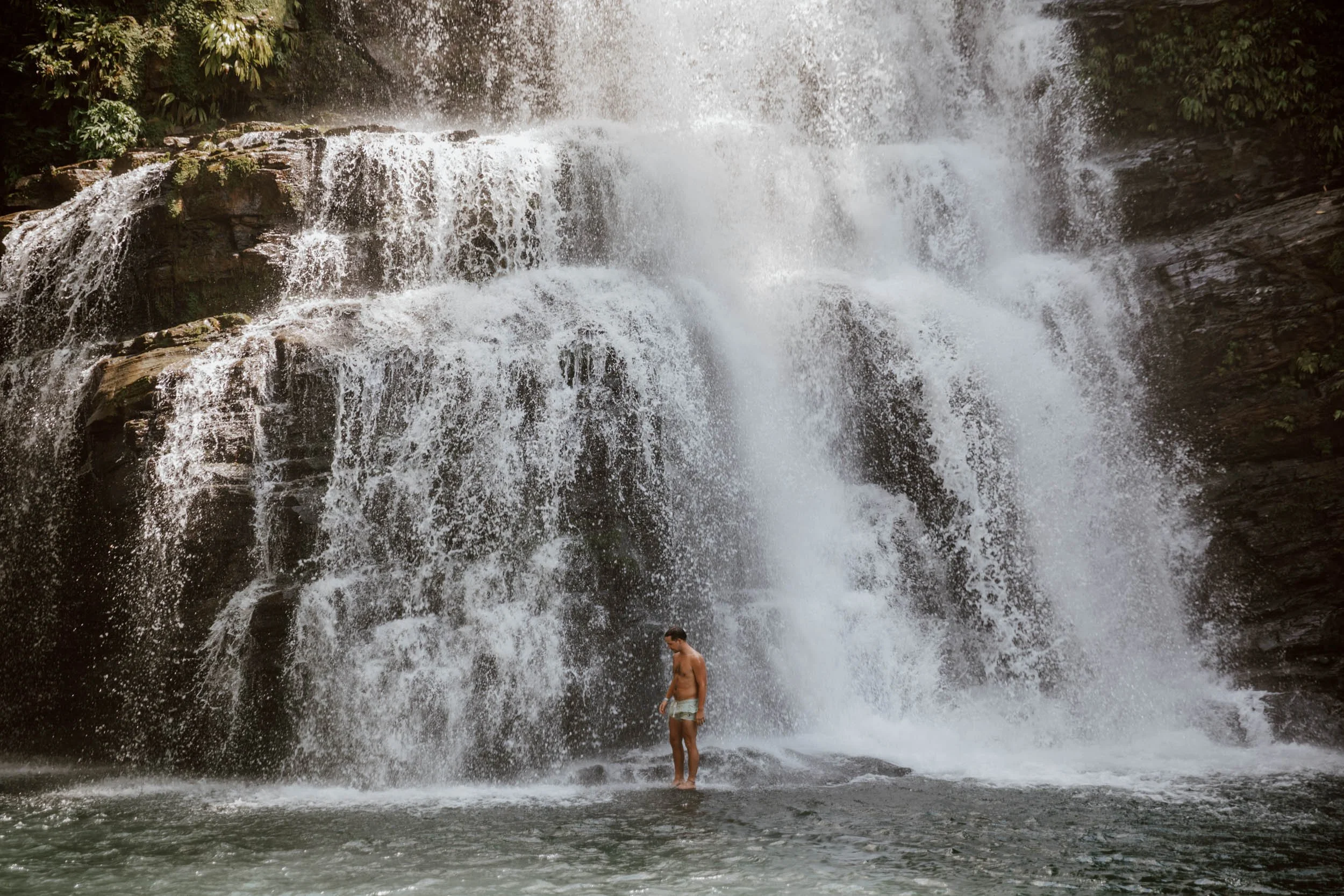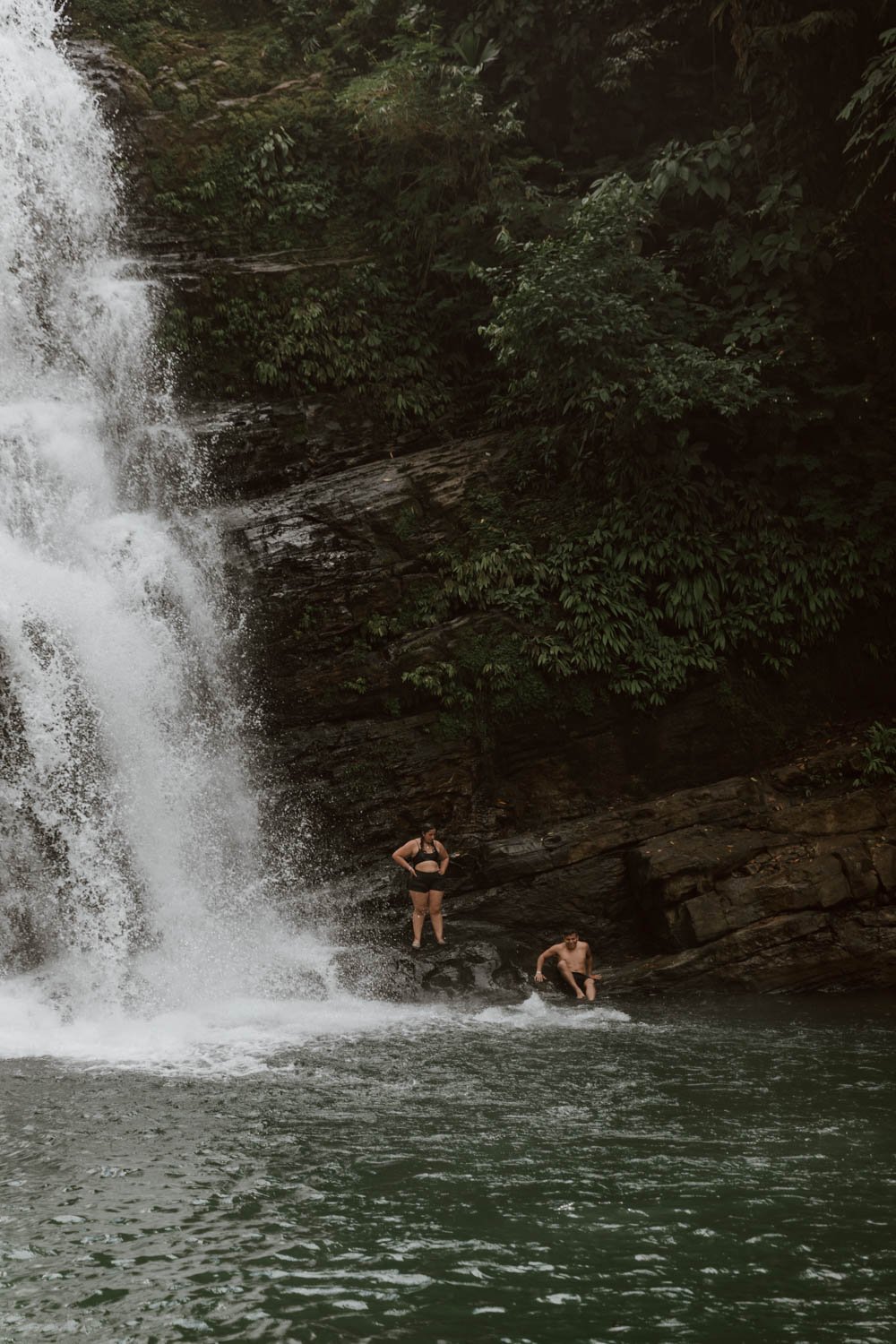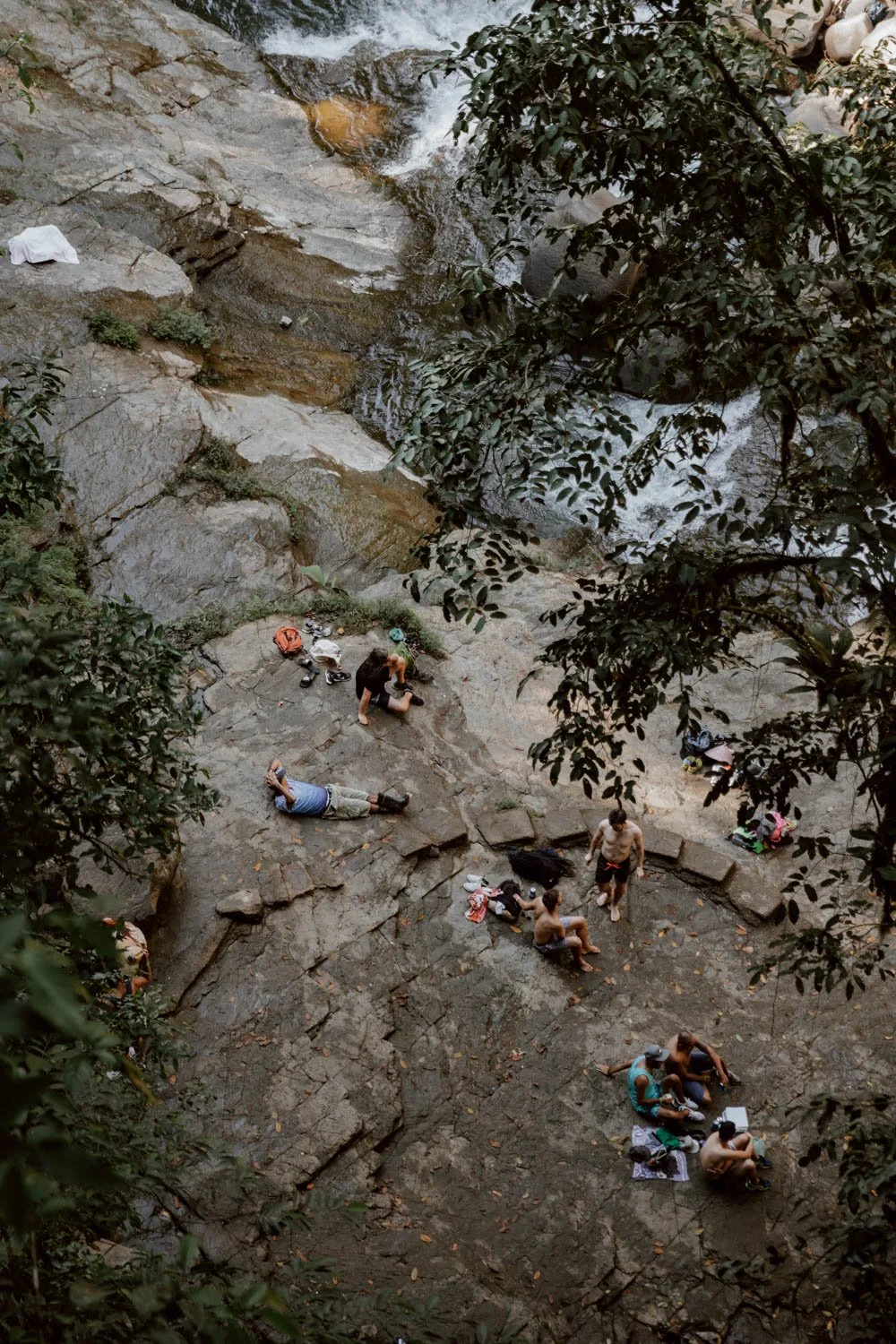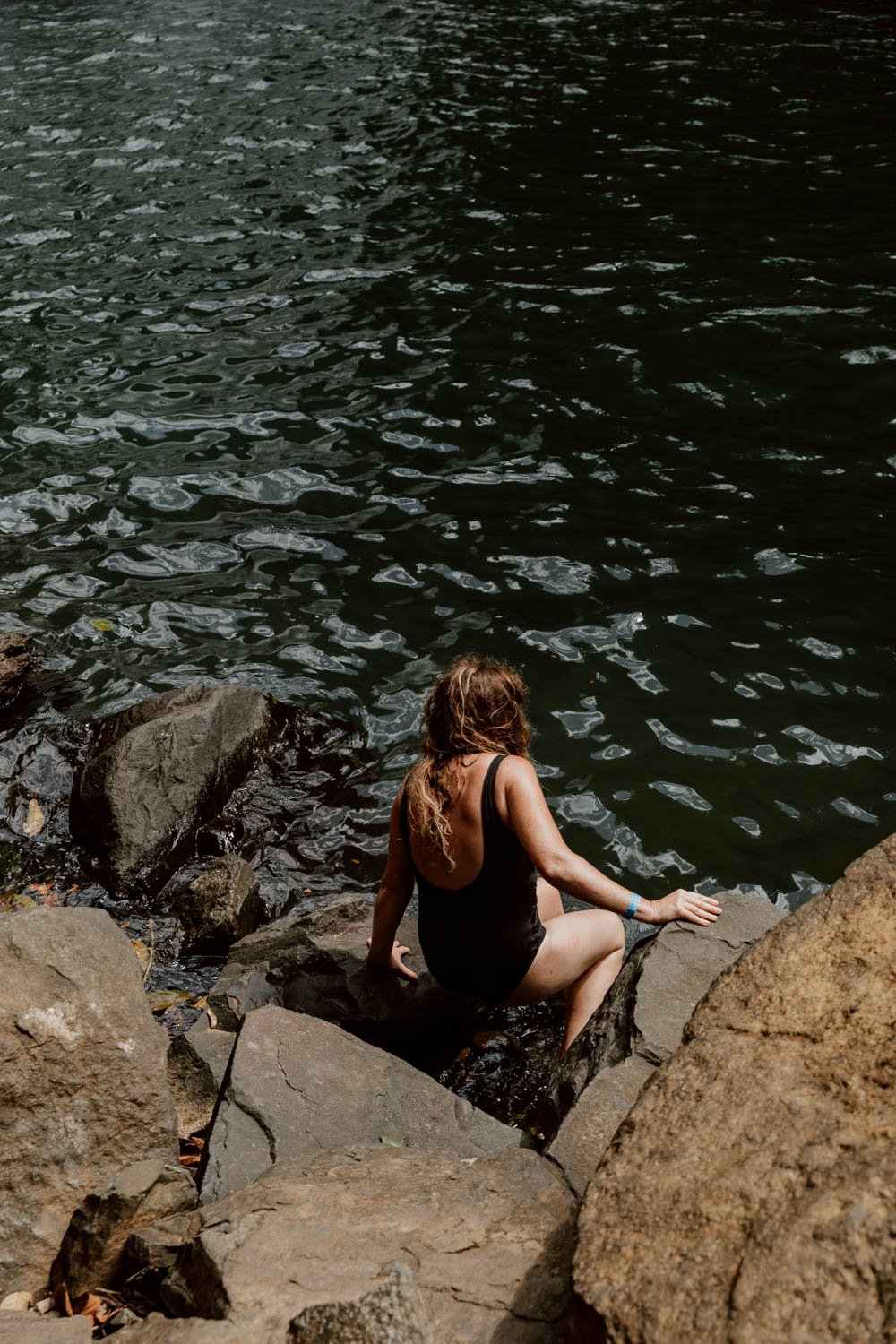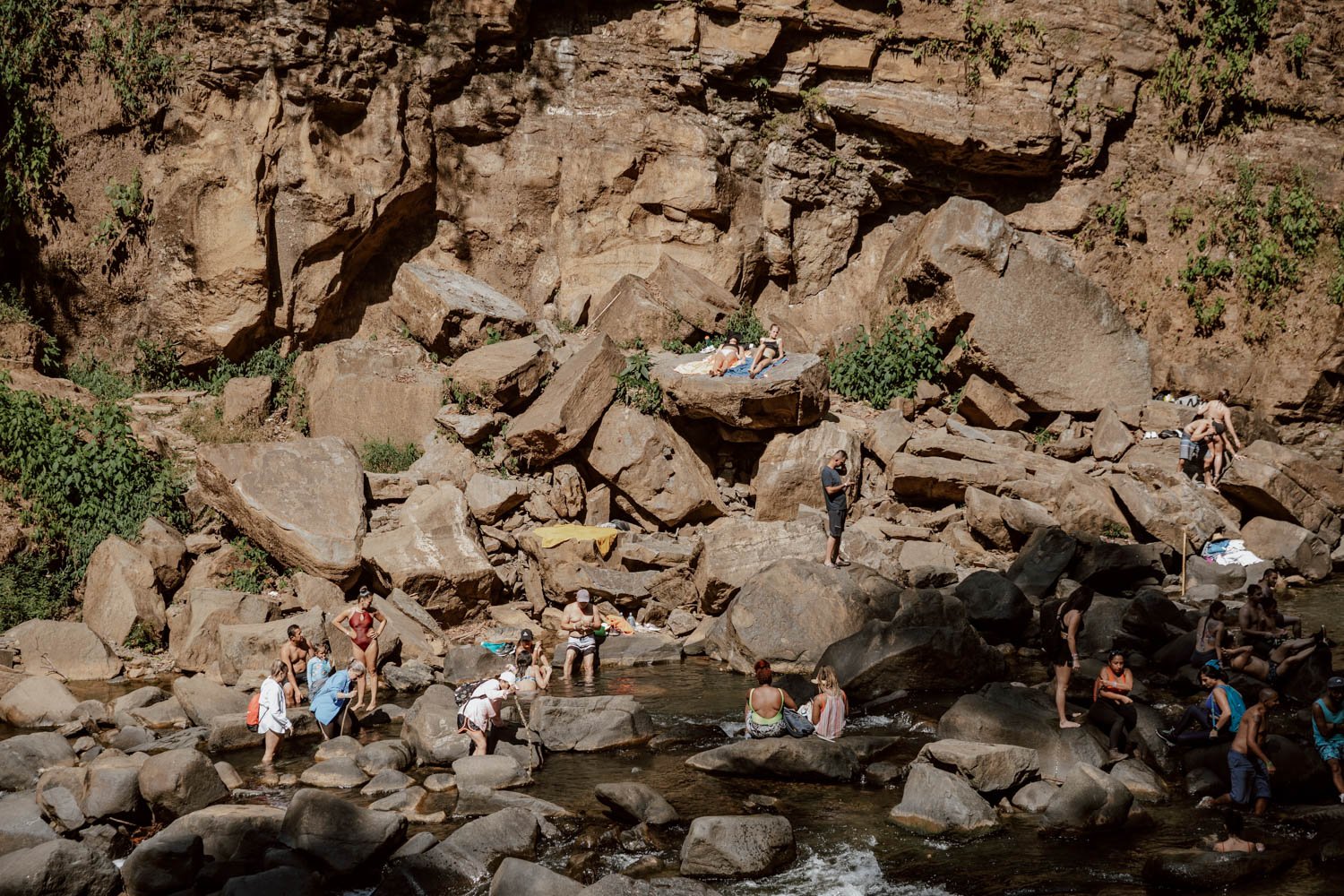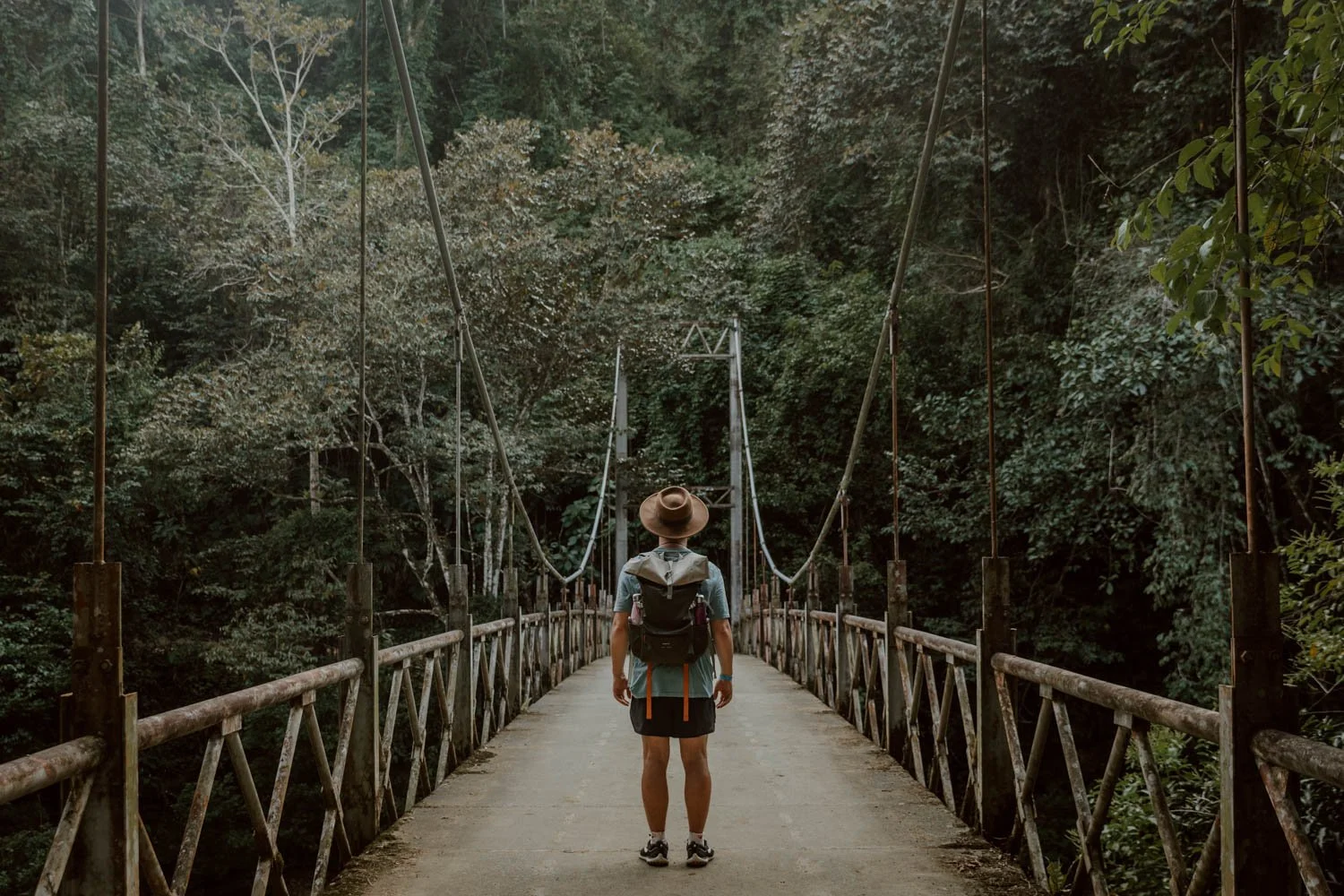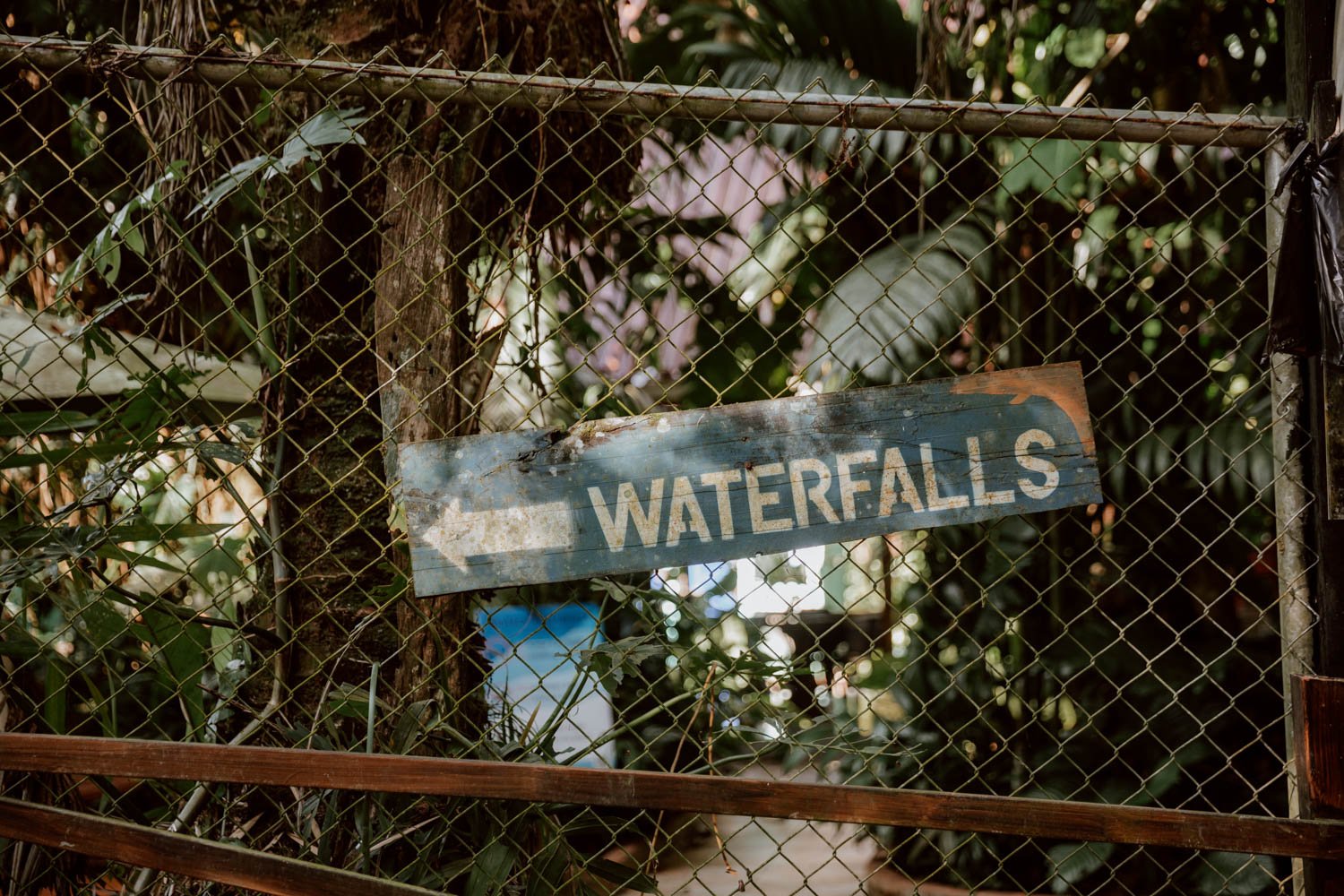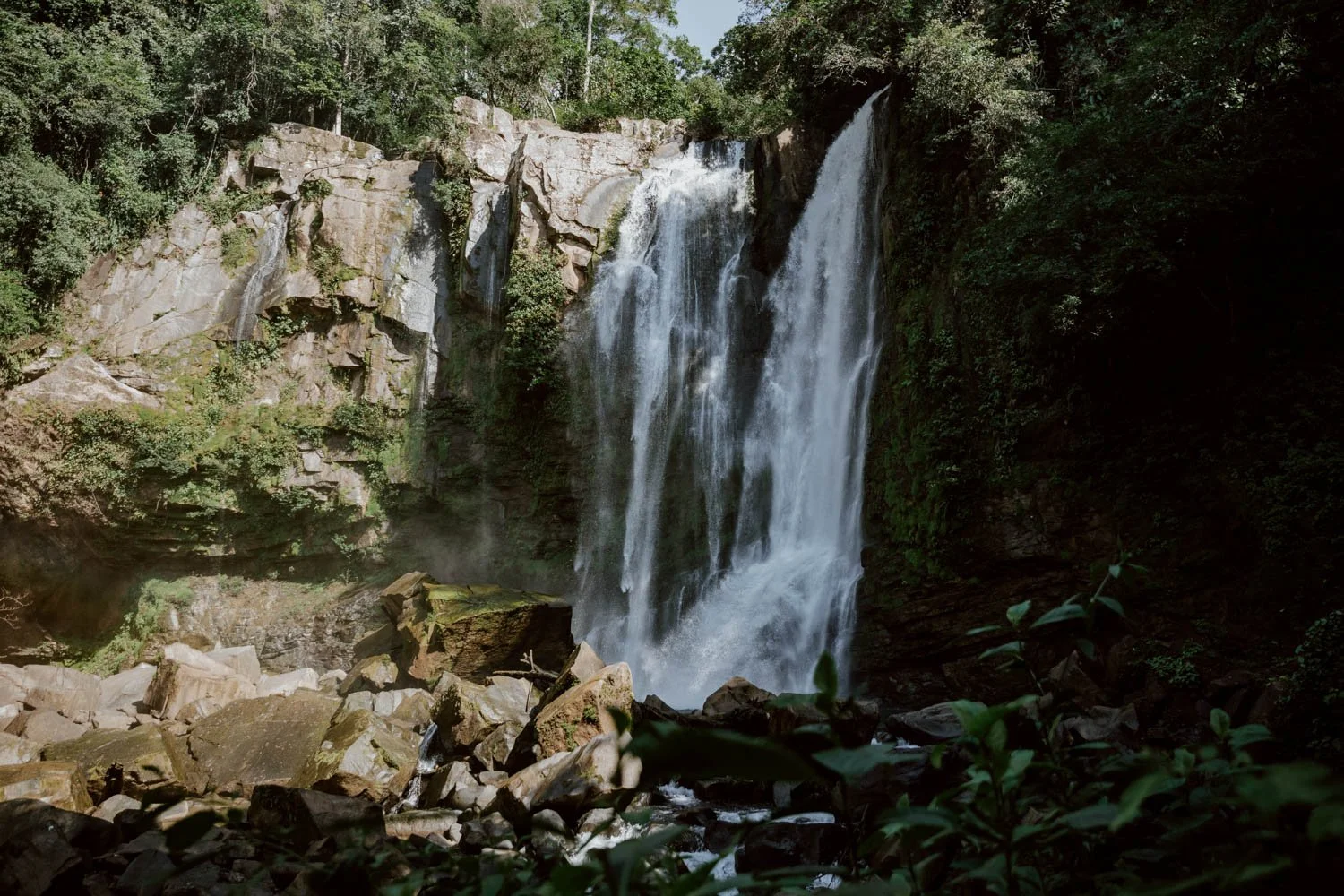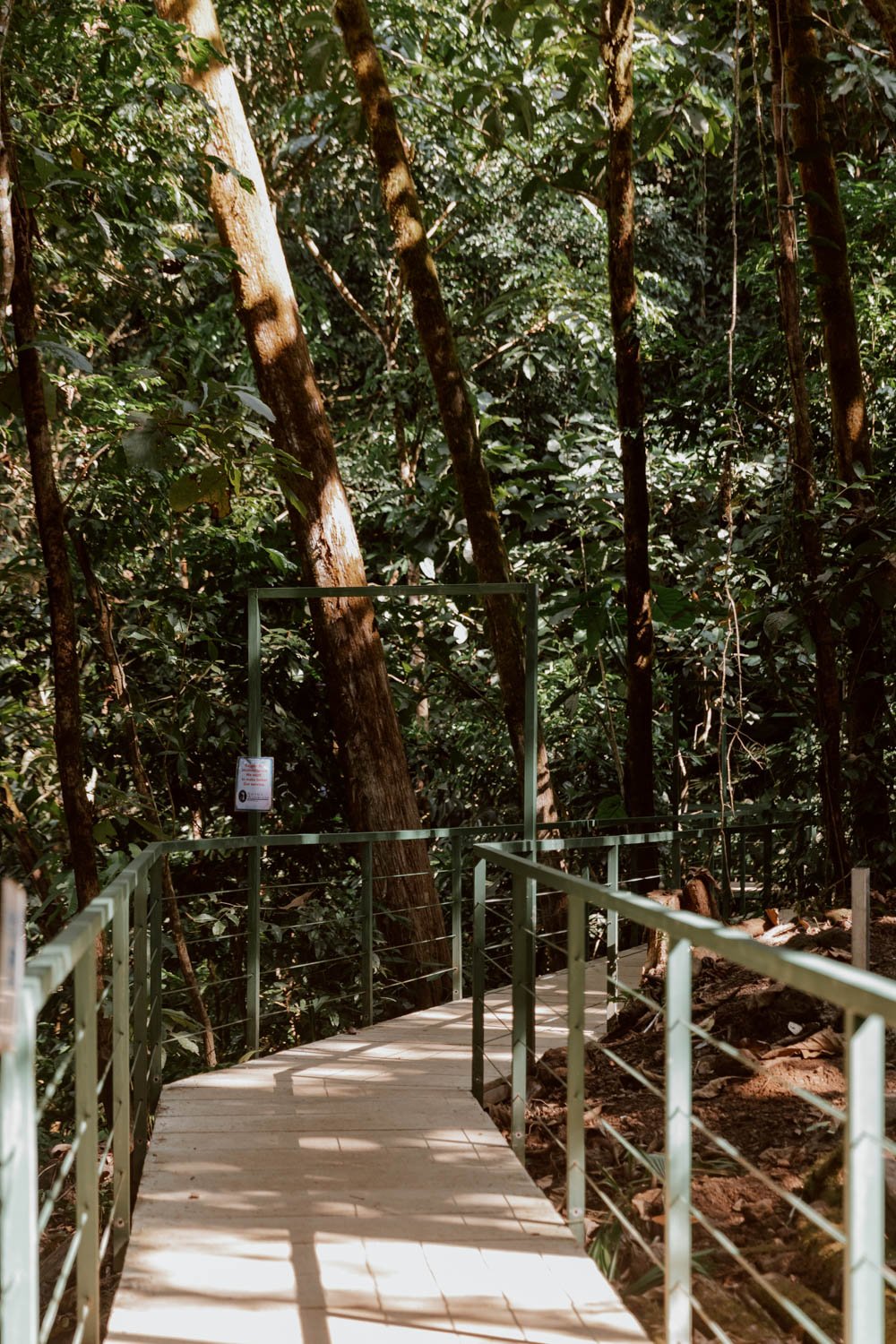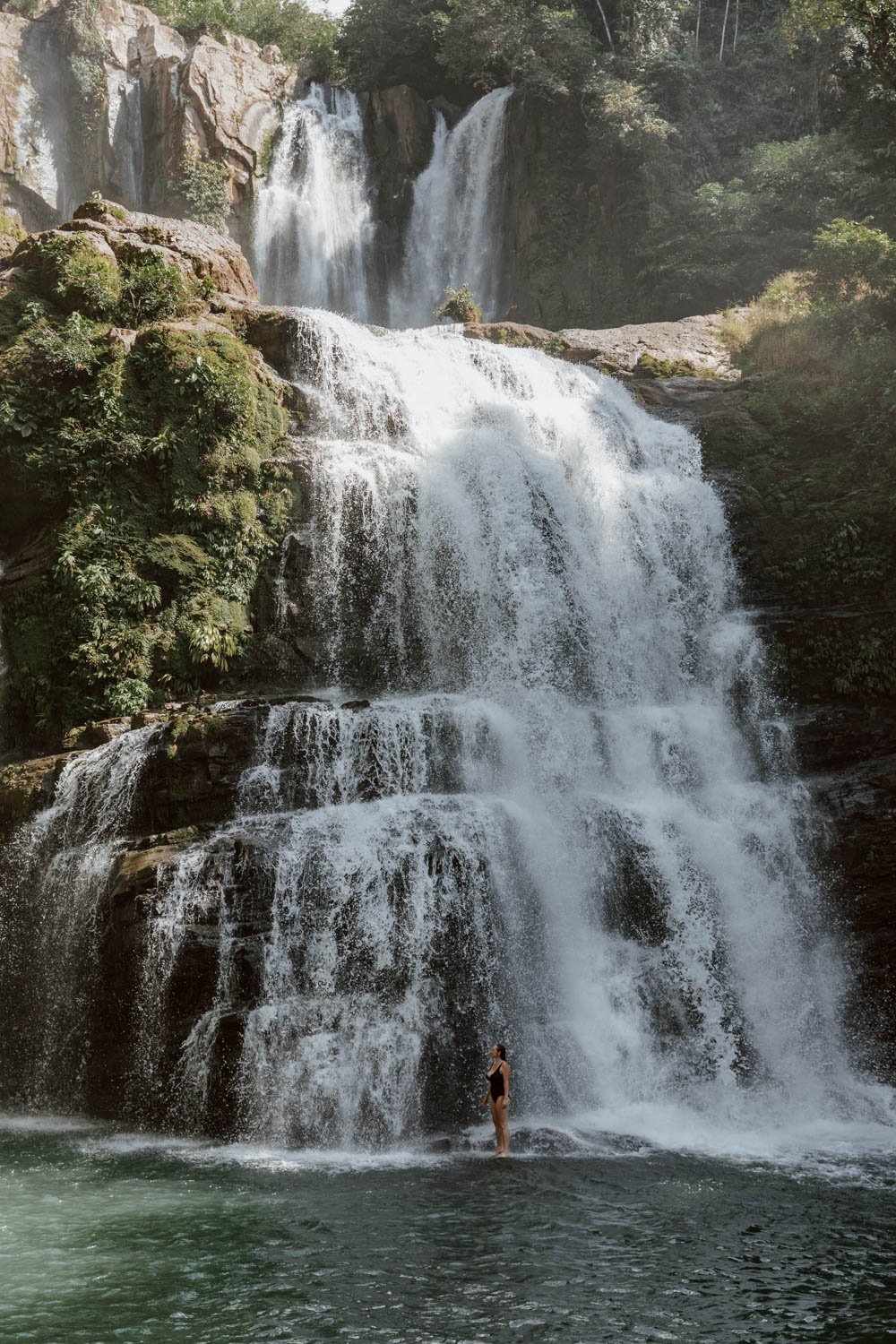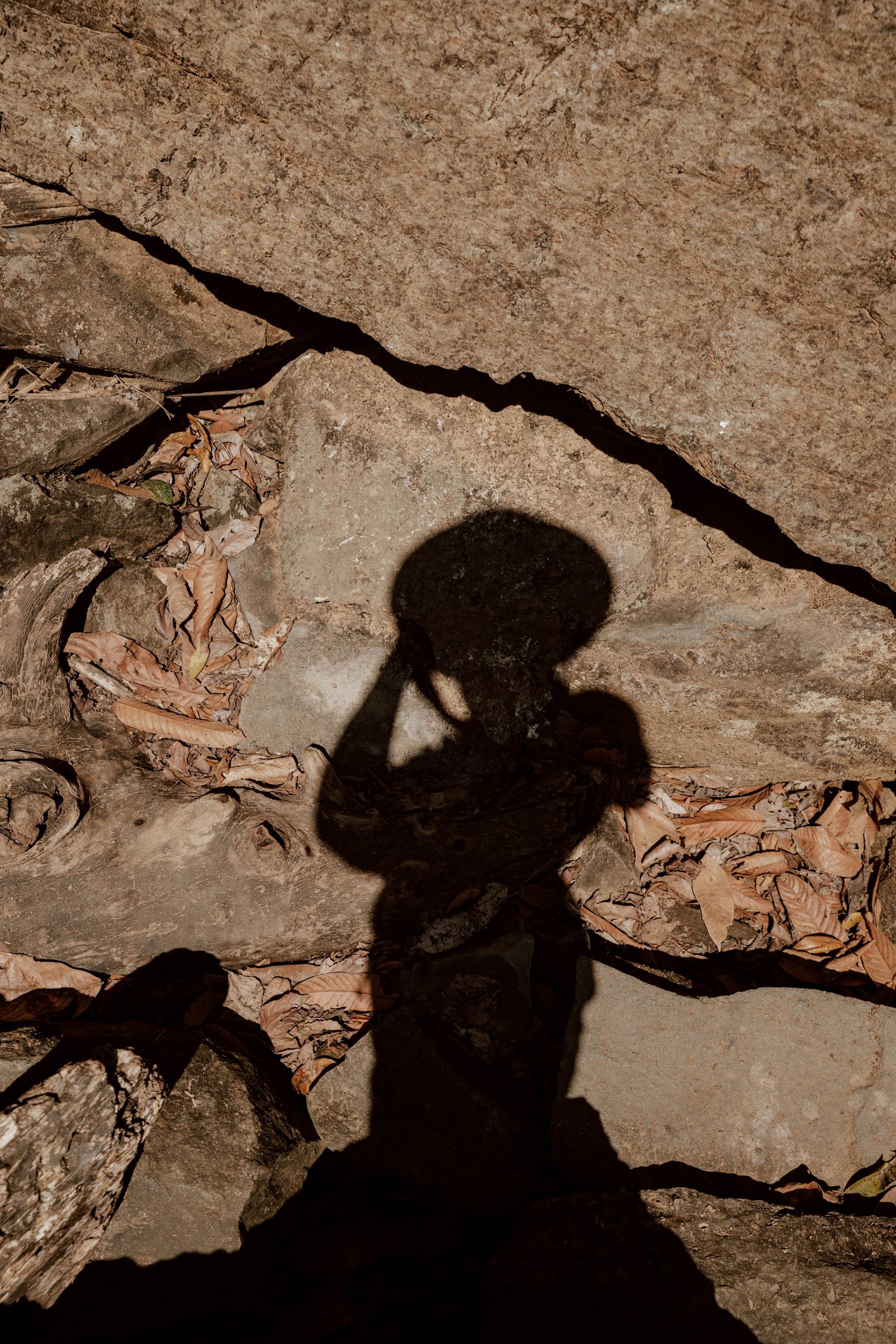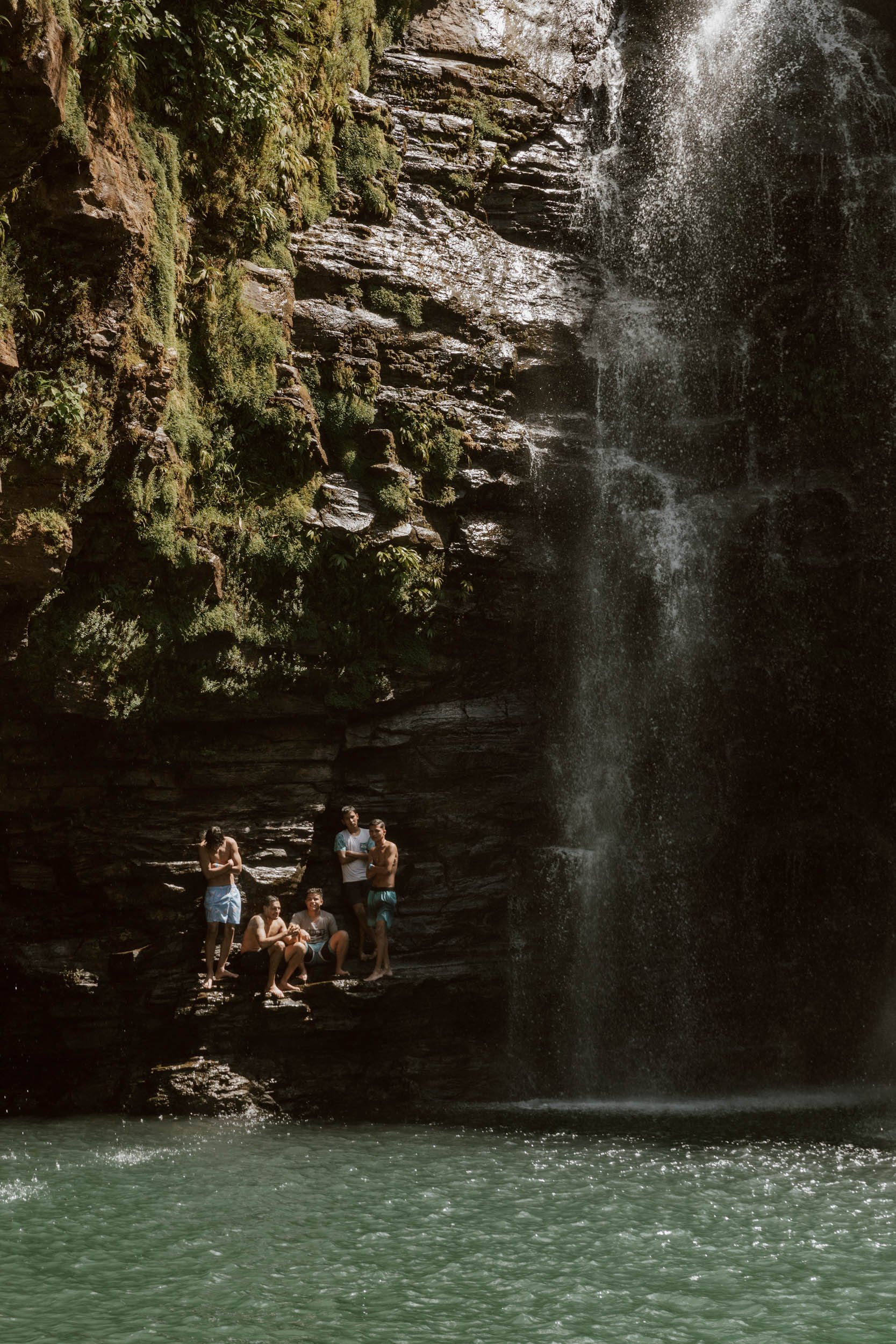Visiting Nauyaca Waterfalls in Costa Rica? Our guide has got you covered for the hike, the transport, the tickets and tips on how to have the best day possible!
Long-time readers of Along Dusty Roads will know that during our escapades in Latin America, chasing a waterfall has often led to disappointment.
Lots of places have one nearby but a dribble is more common than a torrent, meaning that anyone telling us we must visit a waterfall results in a slightly sceptical nod and smile from us.
Thankfully, Nauyaca Waterfall is the exception.
We visited the laid back town of Uvita primarily for whale-watching and beaches, but in our treehouse hostel on a hill, we were told that Nauyaca was far bigger and more powerful than the waterfall we'd visited that morning. A quick image search, and we had decided that we'd be foolish to have made it this far and not made the effort to visit what many people regard as the most beautiful waterfall in Costa Rica.
Room extended, a quick change of our upcoming itinerary, rapid planning done, and we were off early - very early - the next morning. Awaiting us was a stunning pair of powerful waterfalls - one forty-five metre and the other twenty - set within a remote natural setting, a divine natural swimming hole, and a sweaty walk along a dusty road to reach to it all.
So, should you, like us, consider staying an extra night in Uvita so you can also chase this waterfall or just make sure it's in your Costa Rica itinerary before you venture toward the Pacific Coast?
You absolutely must.
In this short post, we've shared everything need to perfectly plan your visit to Nauyaca Waterfalls, whether taking the bus from Uvita, arriving by rental car, or on a day trip from Manuel Antonio.
The Essentials
/ Two waterfalls and a 8-12km roundtrip hike
/ Entry is $10 USD, seven days a week
/ You need at least 3-4 hours
/ Uvita or Dominical is closest base, but Manuel Antonio day trips possible
/ Limited public transport connections
How Long Do You Need At Nauyaca?
Before getting into the details, it's super important to plan around your specific travel style.
If you've got a rental car, then Nauyaca is easy to reach, the hike in/out is shorter, and you can spend anything from a couple of hours to the whole day here.
If travelling with public transport (like we did), then you need to set the alarm clock super early, put aside a whole morning and afternoon, and be prepared for a longer, more strenuous hike experience. Due to very limited bus departures, you also have to decide in advance whether you're going to spend less than two hours or closer to four hours here. If you're doing it on a Sunday, there's some specific factors to consider as well.
Those of you who opt not to walk at all, but instead take the 4x4 tour, are more constrained as you’ve got to follow its schedule, which includes around 2 hours at the waterfalls themselves and set departure times.
We've explained each in more detail in the below sections.
We arrived expecting to simply appreciate and photograph the waterfalls, but instead spent the day jumping in an out of the icy-cold but oh so refreshing blue waterhole, lazing across warm rocks in the sun, and being revitalised under the powerful cascade of Nauyaca. That, alongside the dusty hike through nature, is actually what made this such a perfect day trip rather than somewhere to stop off and leave soon after.
In fact, there's no point rushing in to spend just an hour here and, if you follow our advice to avoid the crowds, you'll hopefully enjoy it just as much as we did and make a day proper day of it!
p.s. Nauyaca is one of the many names for a massive species of pit viper snake! Not sure if that should be taken as a warning or not…
Nauyaca Waterfalls Tickets + Opening Times
The reception office is open from 7am to 2pm, Monday to Saturday.
On Sundays, it's 8am to 2pm.
You have to leave the waterfall by 4.30pm each day (this was 3.30pm when we visited, so do confirm if unsure).
We recommend arriving by 11am at the very latest in order to have enough time to cover the 8 km / 4 mile round trip hike and enjoy the waterfalls, even if you're skipping the hike and travelling in with the official shuttle truck. However, to avoid the crowds and make the most of the setting, we highly recommend trying to get here before 8am (especially on weekends or in high season).
Entry is $10 USD for non-locals, ¢3,500 colones for locals or residents.
At the time of writing, it's necessary to buy or reserve your Nauyaca Waterfalls ticket, entry, or 4x4 tour in advance - the only place to do this is on the official website here. Doing this soon rather than later is recommended during high season (January to April) and weekends.
On arrival, you have to queue, register, and receive your tickets. If you only reserved them, you can pay with cash or card in-person.
The official car park, which has a security guard, costs $3 USD or ¢1,700 colones per vehicle; note that there is no real opportunity to park anywhere else.
If you do not want to do the hike, there is also the option of a 4x4 truck to bring you in and out; we've shared prices and key information in the next section.
If you’re visiting on a day trip from Quepos / Manuel Antonio, but don’t have a rental car, this tour and this tour have great reviews.
How To Get To Nauyaca Waterfalls
Driving + Parking
If you've got a rental car in Costa Rica, it's a straightforward drive to the reception office (Google Maps), right on the side of the road.
Driving time to the reception office from Uvita is about 40-minutes (30kms). A slightly closer base is the beach village of Dominical.
You can also visit the falls on a day trip from Quepos + Manuel Antonio National Park (1 hour, 60-minutes) with your own wheels.
You can temporarily park in front of the office whilst you sort out tickets etc, but it can become oversubscribed with lingering vehicles.
Once tickets and registration is taken care of, go back on the road facing the direction for San Isidro and take the turning on the right (maps), situated about 30 metres after the office and marked by a yellow spray painted tire and a red arrow. It's then a steep, curving drive for a couple of kilometres down a paved road to the main car park (maps); there are often people walking on this road, so drive cautiously.
The car park is exclusively for visitors, has a security guard from 8am to 4 pm, and there’s also bathrooms.
From the car park, you then simply have to exit and cross the bridge to join the main hiking trail to the waterfalls (see the next section for more on this).
Bus to Nauyaca Waterfalls from Uvita
Given Nauyaca’s popularity and relative proximity to a place like Uvita, one would likely assume that public transport to and from it would be plentiful.
That's not the case unfortunately, and the limited schedule actually makes it quite inconvenient to reach without a car (that’s British for ‘a pain in the arse’).
However, for those reading this that don’t have a car, the good news is that with a little careful planning, and a base in either Uvita or Dominical, reaching Nauyaca by bus is perfectly possible. The super early start also mean you’re guaranteed to be the crowds! Here's how to do it:
Make your way to the colourful little bus stop (maps), on the highyway and directly opposite the Uvita bus station, for 5.50 am. It had a yellow sign saying ‘Supermercados Pacífico’ when we were there. If you stay at the fantastic treehouse hostel we did, go left when you reach the highway.
The bus you need to take is heading for San Isidro, scheduled for 6am. It picked us up at 6.15am and, although being late is quite a consistent thing for Costa Rica buses (read 23 Things To Know Before You Visit Costa Rica - published soon), don’t rely on it being late.
This is a popular bus for locals and a popular pick-up point, but with multiple different buses passing around this time be sure to pay attention and be prepared to flag down the correct bus (it’ll say ‘San Isidro’ on the front).
Ask the driver for 'la entrada de Nauyaca' and pay on board. Our tickets cost 1,300 colones each.
The bus arrived at 7am outside the reception office (maps). It's not a bad idea to have the pin in your Google Maps as you're getting close, just in case the driver forgets or speeds past. Once you've taken care of tickets and registration, walk along the road for a minute until you reach the yellow spray painted tire and a red arrow on the right hand side (maps).
If visiting on a Sunday, note that the reception office opens at 8am instead of 7am. This will mean an hour to kill before you can get on with your day, and less of a head start on the crowds. Near the offices there are a couple of sodas for breakfast, but these aren’t open until 7.30 am on Sundays. There is a however a really nice, cheap fruit place a three-minute walk back down the road (back toward Uvita) for a fresh coconut or a banana!
Follow this steep, winding paved road for two kilometres, when you'll arrive at the dusty car park and the official hike start point. Note that, the walk to/from the car park means you’re overall walking distance today will be around 12km, with those arriving + parking only having to cover 8km! This road sees a proportionally high level of vehicles, so pay attention and be aware that the gradient is unforgiving on the knees.
If you're based in Dominical, you'll be catching the same bus, and should plan accordingly based on the above times (it’s around a 15 to 20 minute journey between the beach town and Uvita). In our experience, the bus does go into Dominical to pick up passengers, but it's not a bad idea to double check with a local the day before about where best to wait.
See the end of the post for important advice on the transport options on the way back.
A Taxi or Tour to Nauyaca Waterfalls
If you’re staying in Uvita, don’t fancy the above wake-up call but also don’t have a rental car, then the only alternative is to grab a one-way taxi. Unfortunately, we don’t the know prices as we didn’t ask, so please do let us know in the comments if you get quoted!
The only issue with taking a taxi one-way, beyond the additional cost, is that you either need to agree a pick-up time and fare for the return journey, or sync everything up with closing times and the bus schedule (we explain transport options for the way back at the end of this post).
If you’re visiting Nauyaca from Manuel Antonio or Quepos, the good news is that there are a number of popular full-day tours offered.
Both this one and this one have great reviews, include all the admission fees to the falls and allow you enjoy the hike from the carpark as part of the experience.
If you’d prefer to join a tour which includes transport to the waterfall in a 4x4, then consider this one instead.
The Hike To Nauyaca Waterfalls (And The 4x4 Alternative)
Whether you arrived by rental car, bus, or taxi, you should all be at the same point now - the car park at the bottom of the steep, winding entrance road.
The only vehicles permitted beyond this point or on the hiking trail are the official 4x4 trucks which take up to 10 visitors at a time from the reception office to the waterfalls entrance. We both adore hiking and adding a good few kilometres walk to any activity, but we appreciate that some travellers are less physically mobile, short on time, unwilling to hike, or just lazy.
The 4x4 trucks are the only option to visit Nauyaca Waterfalls without hiking, and mean you just need to walk the steep wooden stairs and platforms on the other side. They depart to a regular daily round-trip schedule through the week, give you around about 2 hours to swim / enjoy the waterfalls, and cost $32 USD per person. Find out more details and book your place on the official website here.
For the walkers, the car park is the start point for the enjoyable 4 km one-way hike along dusty, uneven trails in the middle of nature, forest, and fields to reach the waterfalls. Head out the car park, turn right, cross the bridge over the river Barú and then head left - from there it's signposted and self-explanatory.
The hike isn't a particularly challenging one, but does involve quite a few uphills and you'll get rather sweaty. It took us just over an hour to walk the 6 km from the reception to the falls, so factor in an hour from the car park to cover the 4 km at a leisurely pace.
You can find the full route description, directions, and map here on AllTrails.
At the end of the trail, you’ll see the waterfalls entrance signposted on your left at a blue shelter. There may or may not be a man checking your tickets - he must have been on a break when we visted - and this leads you to a developed facility with toilets, changing rooms, and showers.
This is also the point where the 4x4 trucks drop off and pick-up.
Sidenote | There is an alternative hiking trail to the waterfalls, which was more popular with locals and arrived at a different entry point. We think this begins at a private accommodation or finca, but I’m afraid we don’t know the details. The one above is however the official entry and route.
Visiting The Nauyaca Waterfalls
From the above complex, descend down the steep wooden stairs until you reach a signposted crossroads: you can continue down for Catarata #2 or go right for Catarata #1.
Catarata #2 (The Lower Waterfall)
The lower Catarata #2 (20 metres / 60ft) is the most famous of the two, and the only one you can swim in and hang out by; we gurantee you'll gasp a little when you first approach it.
The cool water is a wonderful antidote to the hot and sweaty hike many of you will have just completed, and there are plenty of large, smooth rocks upon which you can throw down a towel and bask, lizard-like under the Costa Rican sun.
Strong swimmers should absolutely make their way across the pool and enjoy a powerful shower under the hammering flow of the waterfall.
Do note that reaching the waterfall can be a little tricky given then slippy nature of the rocks underfoot (especially the steep staircase down), so take extra special care when making your way down.
This is especially true when crossing the river to access the rocks on the far side (this is where the sun hits best); you’ll need to remove your shoes and socks, and wade across slimy, slippy and occasionally sharp rocks in calf-deep water (Emily fell over once, as did others).
Catarata #1 (The Upper Waterfall)
As tempting as it may be, it’s not possible to swim in the impressive, 45-metre Catarata #1. In fact, this is a waterfall purely to be appreciated from a distance (as you can see in the above photo).
A wooden and metal construction leads you to the very edge of the falls and two separate miradors, although it is possible to cross the large rocks for alternative vantage points. However, it’s super important that should you do this, you exercise extreme caution; we saw several idiots in precarious positions, one guy had a near miss after a slip, and there have been fatalities here.
Tip // No fires, animals, camping or smoking are permitted. Please be a responsible traveller, dispose of your rubbish appropriately, and leave no trace.
The Hike Back
If you enjoy being out and about in nature, then the hike back to the main reception is really quite pleasant - with one caveat.
The last two kilometres, from the car park up to the main road and the bus stop (if you’ve got a rental car, you’ll be driving this part).
Although this section is paved, its steep gradient and relative lack of shade makes it really quite unpleasant and a hard slog. We're both pretty healthy and used to hiking, but I don't think we've ever sweat so much or moaned so much about the uphill (even on this volcano climb in Nicaragua!).
Whether you’re going to the car park or continuing up the hill, heed our advice and:
1. Don't leave the waterfall too late - those of you with a rental car obviously have more luxury to linger, but note that the waterfalls shuts at 4.30pm.
2. It took us 90-minutes to walk from the waterfall to the bus stop, but we'd recommend two hours if you're not too fit or fast.
3. Don't attempt to walk this complete route unless you’re in fairly good health or are otherwise willing to take a really long time to complete it.
4. Ensure you have enough water for the whole stretch.
5. Expect your arse muscles to ache for a few days (the DOMS was real!)
If you can’t face the walk or are running late, then it may be possible to pay directly to one of the 4x4 truck drivers for a ride.
Public Transport Back To Uvita
The bus stop to head back to either Uvita, Dominical or Quepos is across the road from the entrance to the waterfall (around about here on Google Maps). There’s a small shelter, and you’ll know you’re standing in the correct place if the reception office is on the opposite side, down the hill and to the right.
As with the journey out to the falls, there are very limited bus options back to Uvita, with a handful more options if you only need to return to Dominical.
Buses to Uvita | The first bus to Uvita passed the falls at around 9.45 am, which is obviously of no use for day trippers. Therefore your only direct bus option is the 4.45pm, costing 1,300 colones per person. Do note that this bus is often late - 30 minutes late in our case and we were the only people waiting for it, so we were certain we’d missed it, despite showing up 30 minutes early just in case.
Buses to Dominical | If you’re staying in Dominical, or want to return to Uvita by changing here, the good news is that the buses along this route are more frequent. Your options are between a bus at 12.15pm, 4.15pm or 5.15pm. From Dominical there are direct buses to Uvita at 12.30pm, 4pm and 5.30pm, but they don’t really sync up well, meaning you’d have to spend a bit of time waiting around.
Note that the 12.15pm bus back to Uvita is only really appropriate if you get to the waterfall very early, and don’t plan on spending long there. Personally, we’d prioritise longer swimming and sunbathing.
If you miss these buses, your best option is to hitch or grab a taxi to Dominical and organise onward transport from there. However, we saw not a single taxi waiting or passing by, so we wouldn’t rely on this option.
If unsure or feeling stranded, or if you’ve got some time to kill before the bus, then we strongly recommend walking to SODA VISTA A LA MONTAÑA (maps). Aside from cold beers, fresh empanadas, ice cream, and other post-hike plates, the charming owner went out of his way to check when the next bus would be and give us advice. He also said if the bus didn’t arrive or people miss it, he sometimes drives them to Dominical for 10,000 - 15,000 colones so they can catch a connecting bus to Uvita. He speaks excellent English and seemed like a stand-up bloke!
Remember, the sun sets here around about 6pm, and you want to be safely on your way home before then.
WHAT TO WEAR AND BRING
· Bring plenty of snacks and lots of water as there are no amenities or shops on the trail and nothing at the falls. We always have our travel filter water bottles on the road so we can fill up from rivers and any tap whilst significantly reducing our single-use plastic footprint.
· We hiked this trail in our trainers and felt that was adequate. During rainy season however, you may need something more sturdy like a hiking boot. Given the distance and terrain, closed-toe footwear is definitely recommended, so don’t do it in flip-flops.
· Bringing a swimsuit and a towel is an absolute no brainer, as well as plenty suncream.
· Much of the trail is in direct sunlight; a hat is essential.
· Seriously, bring more water - we sweated buckets!
· We saw a number of people that were part of tours using hiking poles - unless you have very bad knees, these are not necessary.
· There was some form of a restaurant about half way along the trail, but we didn’t go in and not sure what it was all about (several caged peacocks too unfortunately). We think it’s more of an option for visiting tour groups than visitors, but let us know if that’s incorrect.
· Before finalising your plans, take a look at weather reports and note the season. Toward the end of dry season, around about March to April, temperatures increase and the flow of water reduces, so the falls may not have the impact as January to February (we visited in January). In the rainy season (May to September), there is an increased chance of a muddy trail and the water looking a bit less attractive in colour!



